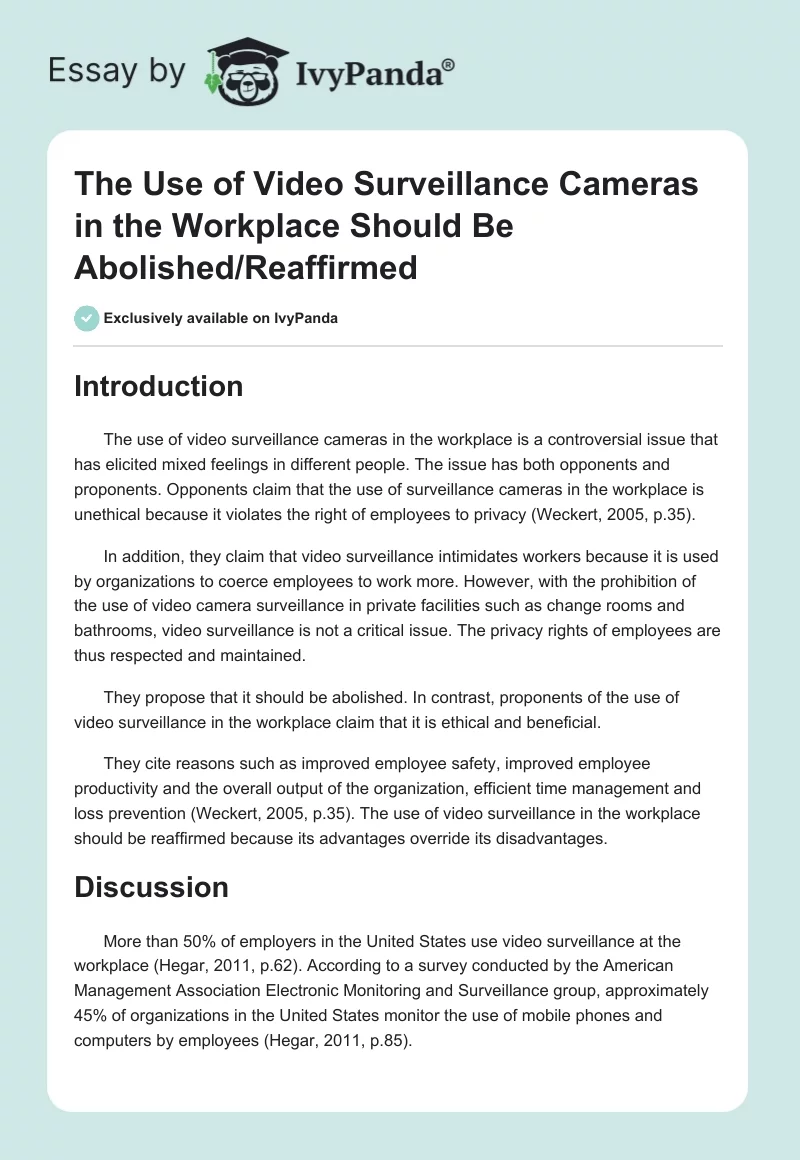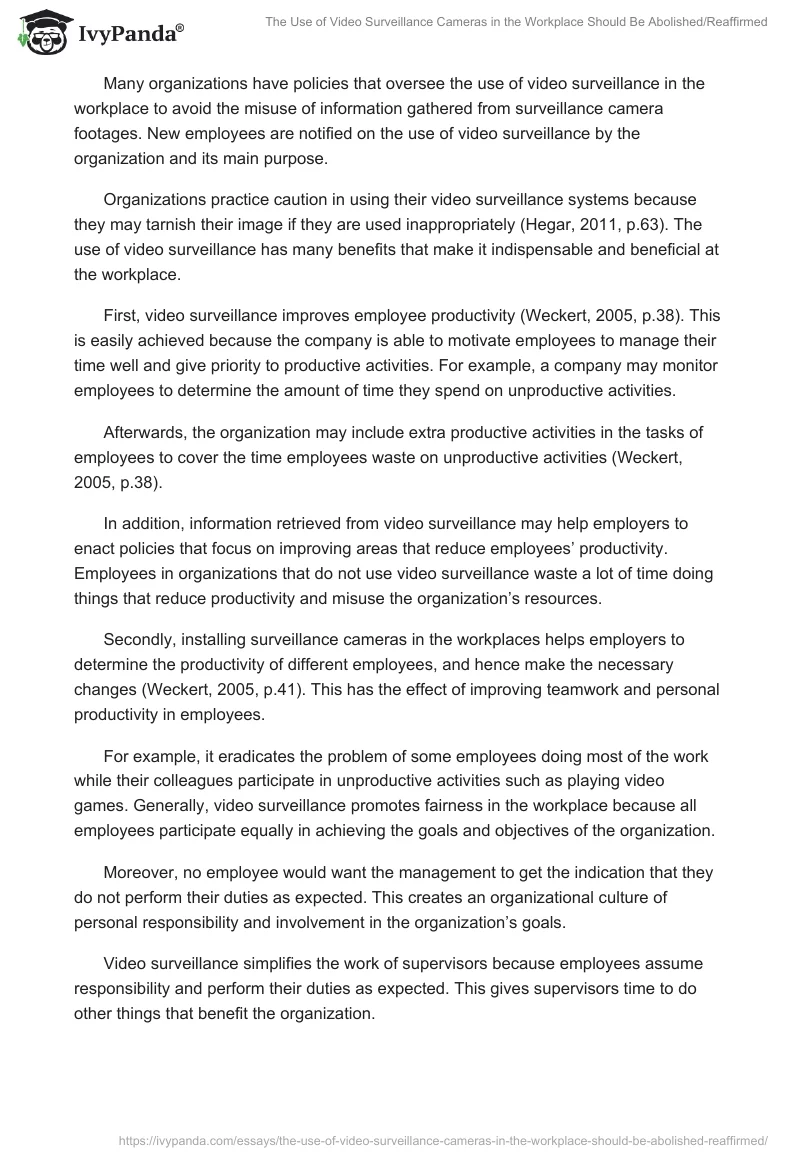Introduction
The use of video surveillance cameras in the workplace is a controversial issue that has elicited mixed feelings in different people. The issue has both opponents and proponents. Opponents claim that the use of surveillance cameras in the workplace is unethical because it violates the right of employees to privacy (Weckert, 2005, p.35).
In addition, they claim that video surveillance intimidates workers because it is used by organizations to coerce employees to work more. However, with the prohibition of the use of video camera surveillance in private facilities such as change rooms and bathrooms, video surveillance is not a critical issue. The privacy rights of employees are thus respected and maintained.
They propose that it should be abolished. In contrast, proponents of the use of video surveillance in the workplace claim that it is ethical and beneficial.
They cite reasons such as improved employee safety, improved employee productivity and the overall output of the organization, efficient time management and loss prevention (Weckert, 2005, p.35). The use of video surveillance in the workplace should be reaffirmed because its advantages override its disadvantages.
Discussion
More than 50% of employers in the United States use video surveillance at the workplace (Hegar, 2011, p.62). According to a survey conducted by the American Management Association Electronic Monitoring and Surveillance group, approximately 45% of organizations in the United States monitor the use of mobile phones and computers by employees (Hegar, 2011, p.85).
Many organizations have policies that oversee the use of video surveillance in the workplace to avoid the misuse of information gathered from surveillance camera footages. New employees are notified on the use of video surveillance by the organization and its main purpose.
Organizations practice caution in using their video surveillance systems because they may tarnish their image if they are used inappropriately (Hegar, 2011, p.63). The use of video surveillance has many benefits that make it indispensable and beneficial at the workplace.
First, video surveillance improves employee productivity (Weckert, 2005, p.38). This is easily achieved because the company is able to motivate employees to manage their time well and give priority to productive activities. For example, a company may monitor employees to determine the amount of time they spend on unproductive activities.
Afterwards, the organization may include extra productive activities in the tasks of employees to cover the time employees waste on unproductive activities (Weckert, 2005, p.38).
In addition, information retrieved from video surveillance may help employers to enact policies that focus on improving areas that reduce employees’ productivity. Employees in organizations that do not use video surveillance waste a lot of time doing things that reduce productivity and misuse the organization’s resources.
Secondly, installing surveillance cameras in the workplaces helps employers to determine the productivity of different employees, and hence make the necessary changes (Weckert, 2005, p.41). This has the effect of improving teamwork and personal productivity in employees.
For example, it eradicates the problem of some employees doing most of the work while their colleagues participate in unproductive activities such as playing video games. Generally, video surveillance promotes fairness in the workplace because all employees participate equally in achieving the goals and objectives of the organization.
Moreover, no employee would want the management to get the indication that they do not perform their duties as expected. This creates an organizational culture of personal responsibility and involvement in the organization’s goals.
Video surveillance simplifies the work of supervisors because employees assume responsibility and perform their duties as expected. This gives supervisors time to do other things that benefit the organization.
Thirdly, video surveillance cameras improve the safety of employees in the workplace (Hegar, 2011, p.72). Video surveillance enhances the security of employees in different ways. It eradicates sexual abuse in the workplace and discourages any form of violence that may result from arguments among employees. In addition, it prevents supervisors from taking advantage of their juniors.
This creates a safe work environment. Employees work more effectively when they are assured of safety than when they are not. In addition, video surveillance inculcates a feeling of being valued and treasured by an organization (Hegar, 2011, p.74). The fact that the organization installs video cameras to improve security, assures employees of the organization’s interest in their well-being.
Fourthly, video surveillance protects an organization’s property and reduces losses (Hegar, 2011, p.76). Some employees take advantage of being alone and steal from their employers. People are afraid to steal from organizations that use video surveillance to safeguard their premises. This is because footages from the surveillance cameras are used to track them down.
These footages give organizations documentation of events that aid them in solving cases of theft. As such, video surveillance discourages and eradicates theft in the organization. On the other hand, it protects the organization’s property. Research has shown that most employees do not consider taking care of an organization’s property as one of their responsibilities.
Therefore, they handle the organization’s property recklessly. Video surveillance encourages employees to take caution when dealing with an organization’s property (Hegar, 2011, p.77). Office equipment such as printers, fax machines, photocopiers and scanners are extremely expensive.
Organizations spend a lot of money to purchase and maintain them. Reckless handling may result in huge expenses because repairing or replacing damaged equipment is expensive.
Opponents of the use of video surveillance in the work place claim that it should be abolished because it infringes on the privacy of the employees (Casilly and Draper, 2009, p.64). In addition, they claim that it intimidates employees and increases their stress levels because it puts them under pressure to work more in order to impress the employer and avoid victimization.
First, use of video surveillance encourages the invasion of employee privacy that is unlawful and unethical (Casilly and Draper, 2009, p.64). For example, video surveillance cameras installed in restrooms and other private areas may e used to spy on employees, which is inappropriate.
In addition, with such personal moments captured on camera, there is a potential danger of illegal use of such video footages (Casilly and Draper, 2009, p.65). For example, videos of employees in the changing room may be posted on the internet thus violating their privacy rights.
This may have severe implications to the organization because every organization has the responsibility to respect and maintain the privacy of its employees. In most workplaces, the problem of video surveillance is negligible because there are state laws that prohibit the use of video surveillance in private places. These places include change rooms, bathrooms and toilet facilities.
Secondly, video surveillance is intimidating because employees consider it a method used by the employer to force them to work more (Hegar, 2011, p.82). This has a negative effect on the morale of employees because they are watched and evaluated by supervisors all the time.
Long-term effects include increased stress levels because employees are always under pressure to perform, owing to the fact that they are being watched all the time (Hegar, 2011, p.82). This may lead to resentment of the employer by employees due to the development of distrust. Employees feel like the employer does not believe that they are responsible enough to execute their duties without surveillance.
Conclusion
The use of video surveillance cameras in the workplace has elicited controversy, with different people giving different opinions. Opponents of the use of video surveillance in the workplace claim that it should be abolished because it is unethical. They cite reasons such as a violation of employee rights to privacy and employee intimidation.
In contrast, proponents claim that the use of video surveillance in the workplace is beneficial and ethical. They cite reasons such as improved employee safety, improved employee productivity, effective time management and a reduction in the organization’s expenses. Video surveillance may result in violation of employees privacy rights. In addition, it may reduce productivity because it creates a feeling of distrust in employees.
This increases their stress levels and consequently reduces their output. However, the benefits are innumerable. Video surveillance improves employee safety by discourages behaviors such as sexual abuse and violence, improves employee productivity and protects the property of the organization.
In addition, it reduces expenses because employees take responsibility and practice caution in handling the organization’s property. The use of video surveillance in the workplace should be reaffirmed because its advantages override its disadvantages.
References
Casilly, L., and Draper, L 2009, Privacy in the Work Place, Pike & Fischer, New York.
Hegar, K 2011, Modern Human Relations at Work, Cengage Learning, New York.
Weckert, J 2005, Electronic Monitoring in the Workplace: Controversies and Solutions, Idea Group Inc, Philadelphia.


